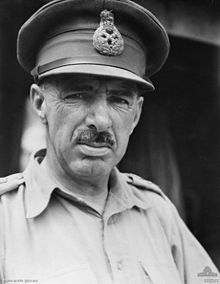Sydney Rowell
Sir Sydney Fairbairn Rowell , KBE , CB (born December 15, 1894 in Lockleys , Adelaide , South Australia ; † April 12, 1975 in South Yarra , Victoria ) was an Australian lieutenant general who was last chief of the Army General Staff between 1950 and 1954 ( Australian Army ) was.
Life
Officer training and World War II
Rowell completed military training and took part in the Battle of Gallipoli (February 19, 1915 to January 9, 1916) after completing it in 1914 during the First World War. After various posts as an officer and staff officer, he took part in an officer exchange in the United Kingdom between January 4, 1935 and January 3, 1937 and was General Staff Officer (G 2) of the 44th British Infantry Division during this time. There he received on July 1, 1935 first the rank of lieutenant colonel and was promoted to lieutenant colonel on January 1, 1936 . He then graduated from Imperial Defense College (IDC) in London from January 4, 1937 to February 5, 1938 . After his return he acted between March 2 and July 31, 1938, initially as head of the Military Operations and Intelligence Service at Army Headquarters, where he was then a staff officer at the Army Inspector General from July 31 to August 25, 1939 was. He was then assigned to the headquarters of the Army Command South (Southern Command) from August 26 to October 12, 1939 and, after being promoted to colonel on October 13, 1939, served as a general staff officer between October 13, 1939 and April 3, 1940 ( G 1) of the 6th Australian Infantry Division.
On April 4, 1940, Rowell was awarded the temporary rank of brigadier general and as such was brigadier general in the General Staff of the 1st Australian Corps from April 4, 1940 to August 31, 1941, which subsequently worked in the Middle East , Greece and North Africa was used. He took part in the Battle of Greece and the Syrian-Lebanese campaign (June 8 to July 14, 1941). After he was awarded the temporary rank of major general on September 1, 1941, he acted as Deputy Chief of the Army General Staff between September 1, 1941 and April 5, 1942. On April 6, 1942, he was awarded the temporary rank of Lieutenant General, after which he was Commanding General ( General Officer Commanding ) of the 1st Australian Corps from April 6 to September 30, 1942 and temporarily participated in the Battle of the Kokoda Track (21 July to November 16, 1942). There he was promoted to major general on September 1, 1942 . From January 28 to December 27, 1943, he was in command of the Australian contingent of troops in the Middle East as well as an Australian liaison officer to the British Army Command in the Middle East (Middle East Command) and subsequently between December 31, 1944 and January 7, 1946 Head of Tactical reconnaissance in the British Ministry of war ( war Office ) .
Post-war period and Chief of the Army General Staff

After Rowell had returned to Australia, on January 8, 1948 he was again awarded the temporary rank of lieutenant general. He then acted between January 8, 1946 and May 16, 1950 as Vice-Chief of the General Staff of the Army and was also a member of the Military Board from March 1, 1946 to April 16, 1950 . He was promoted to lieutenant general on October 1, 1948 .
On April 17, 1950, he replaced Lieutenant General Vernon Sturdee as Chief of the General Staff of the Army ( Australian Army ) and held this position until December 16, 1954, when he was succeeded by Lieutenant General Henry Wells . At the same time he was by virtue of office from April 17, 1950 to December 16, 1954, the first member of the military committee and head of the Australian section of the Imperial General Staff in the British War Office. During his tenure as Chief of the General Staff, Australian troops were deployed in the Korean War . He was also since April 15, 1950 Colonel of Honor of the 3rd / 9th South Australian Mounted Rifles . On June 1, 1953 he was made Knight Commander of the Order of the British Empire (KBE), so that from then on he carried the suffix "Sir". On December 16, 1954, he retired from active military service after forty years of service. He was also awarded the title of Companion des Order of the Bath (CB).
Web links
- Entry in generals.dk
- Knighs and Dames (leighrayment.com)
| personal data | |
|---|---|
| SURNAME | Rowell, Sydney |
| ALTERNATIVE NAMES | Rowell, Sydney Fairbairn (full name) |
| BRIEF DESCRIPTION | Australian Lieutenant General |
| DATE OF BIRTH | December 15, 1894 |
| PLACE OF BIRTH | Lockleys , Adelaide , South Australia , Australia |
| DATE OF DEATH | April 12, 1975 |
| Place of death | South Yarra , Victoria , Australia |

